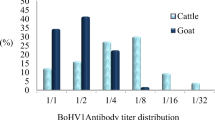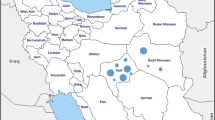Summary
The association between antibody titres against bovine virus diarrhoea virus (BVDV), infectious bovine rhinotracheitis virus (IBRV) and rinderpest disease virus (RPDV) in buffaloes was investigated in a cross-sectional study. Thirty-six lactating buffaloes from a herd in Landhi Cattle Colony, Karachi were bled and serum samples subjected to a micro-neutralisation test at the Plum Island Animal Disease Center, USA, to categorise each buffalo either as positive or negative against each of 3 viral antigens. Log-linear analysis was used to evaluate the association among 3 categorical variables.
The “best-fitting” log-linear model was the model of complete independence. This model includes all 3 main effects (BVDV, IBRV, RPDV), suggesting that the seropositivity of buffaloes against these viral antigens tended to occur independently. Estimates of parameters of the model showed that the proportion of buffaloes seropositive (97·2%) to RPDV antigen tended to be higher than expected, whereas the proportion of BVDV seropositive (30·6%) and IBRV seropositive (16·7%) buffaloes tended to be smaller than expected.
Résumé
L'association entre les titres d'anticorps contre le virus de la diarrheé virale bovine (VDVB), le virus de la rhinotrachéite infectieuse bovine (IBRV) et le virus de la peste du bétail (RPDV) fut analysé chez des buffles par une étude trans-sectionnelle. Pour 36 buffles, en période d'allaitement, d'un troupeau de Landhi, Karachi du sang fut prélevé et les sérums furent soumis au test de micro-neutralisation au Plum Island Animal Disease Centre, USA, pour répartir chaque buffle comme positif ou négatif pour chacun des 3 antigènes viraux. Une analyse logarithmique fut utiliseé pour évaluer l'association des variables.
Le modèle logarithmique le plus concordant fut le modèle d'indépendance complète. Ce modèle considère 3 principaux évènements (VDVB, RPDV, IBRV) suggèrant que la séropositivité des buffles face aux antigènes viraux est indépendante.
L'évaluation des composantes du modèle montra que la proportion des buffles séropositifs (97,2%) pour l'antigène du RPDV tendait à être plus élevé que prévu alors que la porportion de buffles séropositifs pour VDUB (30,6%) et pour IBRV (16,7%) tendait à être plus faibles que prévu.
Resumen
Se investigó la asociación entre los títulos de anticuerpos frente al virus de la diarrea vírica bovina (BVDV), el virus de la rinotraqueítis infecciosa bovina (IBRV) y el virus de la peste bovina (RPDV) en búfalos. Se obtuvieron muestras de suero de 36 búfalas en lactación procedentes de la Landhi Cattle Colony de Karachi. Dichas muestras fueron sometidas al test de microneutralización en el Plum Animal Disease Center de los Estados Unidos con objeto de clasificar cada animal como positivo o negativo frente a cada uno de los 3 antígenos virales. Se utilizó un modelo semilogarítmico para evaluar la asociación entre las tres variables.
El modelo semilogarítmoco que mejor se ajustó a los resultados fue el de independencia completa. Dicho modelo incluye los 3 efectos principales (BVDV, IBRV y RPDV) y sugiere por tanto que la seropositividad de los búfalos frente a los tres antígenos ocurre independientemente. Las estimaciones de los parámetros del modelo mostraron que la proporción de búfalos seropositivos frente al RPDV (97·2%) tendió a ser superior a la esperada, mientras que la proporción de seropositivos frente al BVDV (30·6%) y al IBRV (16·7%) tendió a ser inferior a la esperada.
Similar content being viewed by others
References
Baker, J. C. (1987). Bovine viral diarrhea: a review.Journal of the American Veterinary Medical Association,190, 1449–1457.
Bishop, Y. M. M., Fienberg, S. E. &Holland, P. W. (1975).Discrete Multivariate Analysis. Theory and Practice. Cambridge, MIT: MIT press.
Brownlie, J., Clark, M. C. &Howard, C. J. (1984). Experimental production of fatal mucosal disease in cattle.Veterinary Record,114, 535–536.
Dixon, W. J., Brown, M. W., Engelman, L., Frane, J. W., Hill, M. A., Jennrich, R. I. &Toporek, J. D. (1990).BMDP Statistical Software. (University of California Press, Berkeley, CA).
Durrani, N. U., Athar, S. M. &Asif, M. (1988). Rinderpest in Landhi Dairy Colony.Tropical Animal Health and Production,20, 177–180.
Fienberg, S. E. (1980).The Analysis of Cross-Classified Categorical Data. Cambridge, MIT: MIT press, pp 71–139.
Horohov, D. W., Wyckoff, J. W., Moore, R N. &Rouse, B. T. (1986). Regulation of herpesvirus simplex virus-specific cell-mediated immunity by a specific suppressor factor.Journal of Virology,58, 331–338.
Jeffery, M. &Hagg, R. A. (1988). Concurrent bovine virus diarrhoea andCampylobacter fetus infection in an aborted fetus.Veterinary Record,122, 89–90.
Kendrick, J. W. (1971). Bovine viral diarrhoea mucosal disease virus infection of pregnant cows.American Journal of Veterinary Research,327, 533–544.
Larntz, K. (1978). Small sample comparisons of exact levels for Chi-square goodness-of-fit statistics.Journal of American Statistical Association,73, 253–263.
Lennette, E. H. &Schmidt, N. J. (1979).Diagnostic Procedures for Viral and Rickettsial Infections. 5th ed. Washington DC. American Public Health Association.
McClurkin, A. W. Littledike, E. T., Cutlip, R. C., Frank, G. H., Coria, M. F. &Bolin, S. R. (1984). Production of cattle immunotolerant to bovine virus diarrhoea virus.Canadian Journal of Comparative Medicine,48, 156–161.
Memon, G. M. (1985). Studies on rinderpest like disease prevalent in livestock at Landhi Cattle Colony, Karachi. Final Report of the PARC Research Project, pp 38.
Potgieter, L. N. D., McCracken, M. D., Hopkins, F. M., Walker, R. D. &Guy, J. S. (1984). Experimental production of bovine respiratory tract disease with bovine viral diarrhea virus.American Journal of Veterinary Research,45, 1,582–1,585.
Pritchard, W. R. (1963). The bovine viral diarrhea-mucosal disease complex.Advances in Veterinary Sciences,8, 1–47.
Reggiardo, C. (1979). Role of BVD virus in shipping fever of feedlot cattle: case studies and diagnostic considerations.Proceedings of the Annual Meeting of the American Association of Laboratory Diagnosticians,22, 315–320.
Reggiardo, C. &Kaeberle, M. L. (1981). Detection of bacteremia in cattle inoculated with bovine viral diarrhea virus.American Journal of Veterinary Research,42, 218–221.
Roeder, P. L. &Drew, T. W. (1984). Mucosal disease of cattle: a late sequel to foetal infection.Veterinary Record,114, 309–313.
Wray, C. &Roeder, P. L. (1987). Effect of bovine virus diarrhoea-mucosal disease virus infection on Salmonella infection in calves.Research in Veterinary Science,42, 213–218.
Author information
Authors and Affiliations
Rights and permissions
About this article
Cite this article
Akhtar, S., Asif, M. Epidemiologic association between antibody titres against bovine virus diarrhoea virus, rinderpest disease virus and infectious bovine rhinotracheitis virus in a buffalo herd. Trop Anim Health Prod 28, 207–212 (1996). https://doi.org/10.1007/BF02240936
Accepted:
Issue Date:
DOI: https://doi.org/10.1007/BF02240936




